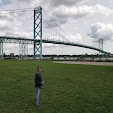When I last spoke about construction projects in the City of New York, we discussed the new connector ramp between the RFK Bridge and the Harlem River Drive, a much-needed piece of the transportation puzzle that filled a glaring “missing link” in the whole network. A short distance away from there, in the Hunts Point section of the south Bronx, a much larger project of similar intent is now underway that promises to improve traffic circulation in a part of the City that has been lacking logical connectivity for decades.

The above photos detail a trip along the westbound side of the Bruckner Expressway (I-278) through the Hunts Point Project work area. Temporary unconventional traffic shifting and realignments will be necessary in the coming years as construction proceeds in the vicinity.
The scope of this project includes the reconstruction of the Bruckner Expressway/Boulevard mainline between Bronx River Avenue and Hunts Point Avenue, including the replacement of bridge decks and the widening of mainline roadways through the area. New flyover ramps are to be constructed that will directly connect the eastbound Bruckner/southbound Sheridan corridors with the truck entrances to the Hunts Point Market, and connect the Market with the northbound Sheridan, taking that substantial commercial traffic off of local streets and streamlining access to Market Terminals. The project’s timeline and staging are complicated by a variety of factors. Amtrak & CSX Railroads own & operate busy trackage, both along the Northeast Corridor (which runs directly through the project area), and on a separate active siding that connects the NEC mainline with the Terminal Markets. The vital Bruckner & Sheridan transportation arteries must be kept open through the project’s duration, meaning that special considerations related to work staging and traffic management are to be utilized.
This $460 million design-build
contract is being executed by a joint venture contracting team led by Skanska
and ECCO III Enterprises and substantial completion of the project is
anticipated by the end of 2022. This is the first of three planned contracts
aimed at renewing the entire Bruckner Expressway corridor between the RFK
Bridge and Bronx River Parkway; the following two contracts will further
address travel deficiencies in the area by adding additional ramps along the
Bruckner corridor, and rehabbing the existing elevated viaduct through Hunts Point.
All in all, about a decades-worth of work lies ahead for a long-neglected area
of the City that will finally be getting a semblance of the modern
transportation infrastructure it deserves.












Comments
I have worked in The Point for over 30 years. I have never experienced such congestion and lawlessness on the streets. The people responsible for this project including the political people should move there offices down here and experience the disaster they have created.